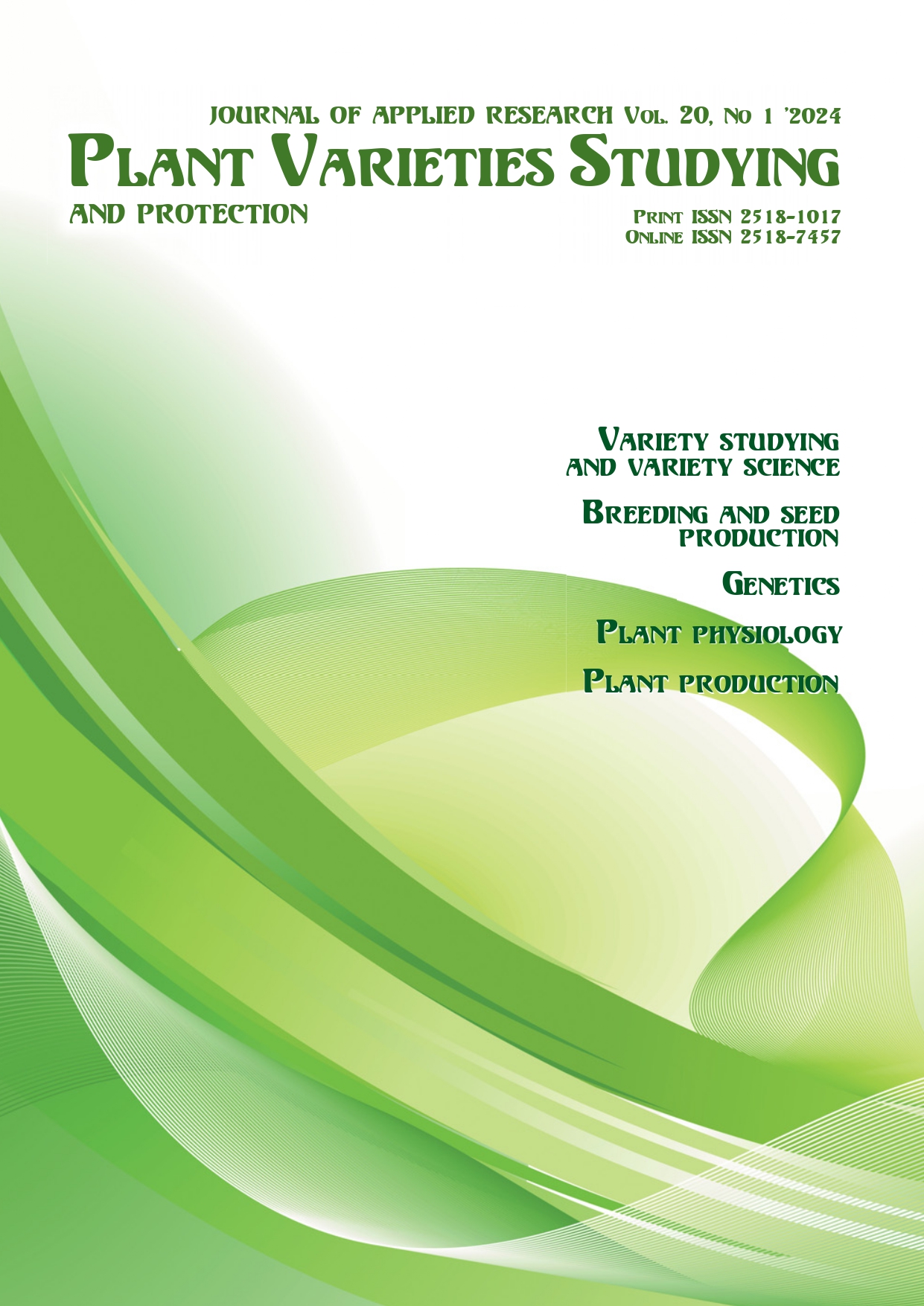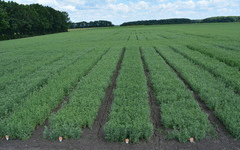Selection of pollinators for promising largefruited varieties of sweet cherry Cerasus avium (L.) Moenh in ForestSteppe conditions
DOI:
https://doi.org/10.21498/2518-1017.20.1.2024.298498Keywords:
productivity, pollen viability, pollination efficiency, modern assortment, fruit settingAbstract
Purpose. Selection of effective pollinators for promising largefruited sweet cherry varieties in the ForestSteppe of Ukraine. Methods. Field, laboratory and analytical methods were used in the research. Pollen viability and selffertility were determined in 29 varieties of different ripening periods. Pollinators were selected for the group of mediumlate and late varieties (‘Krupnoplidna’, ‘Talisman’, ‘Stark Hardy Giant’, ‘Anons’, ‘Temporion’, ‘Zodiak’, ‘Annushka’, ‘Anshlah’ and ‘Regina’). The surveys were carried out in accordance with the approved scientific and methodological recommendations. Results. In the group of early varieties, the highest pollen quality (77.9%) was produced by ‘Valerii Chkalov’; among the varieties of medium ripening period – ‘Talisman’ (control) (87.3%), ‘Yaroslavna’ (78.8%) and ‘Melitopolska Myrna’ (86.7%); medium late and late – ‘Drogan’s grosse gelbe’, ‘Kordia’, ‘Regina’, ‘Zodiac’ and ‘Annushka’ (80.9–88.0%). A full crop of all the varieties studied can only be guaranteed under the condition of crosspollination. The highest level of fruit set (47.9–56.1%) in ‘Talisman’, ‘Temporion’, ‘Stark Hardy Giant’ and ‘Anshlah’ was due to pollen of ‘Krupnoplidna’. Conclusions. The versatility of ‘Donchanka’ as a pollinator was revealed. When it was used, fruit set in relation to free pollination was 111.2–148.8%. ‘Krupnoplidna’ and ‘Stark Hardy Giant’ proved to be mutual pollinators and effective pollinators for the vast majority of varieties. The variety ‘Regina’ was best pollinated by ‘Donchanka’ and ‘Drogan’s grosse gelbe’ with fruit set of 24–26.6% and 134.8–149.4% respectively compared to the control.
Downloads
References
Kishchak, О. A., & Kishchak, Yu. P. (2021). Scientific achievements and realities of the sweet cherry (Cerasus avium L.) cultivation intensification at the current stage of the horticultural science development. Horticulture, 76, 71–81. doi: 10.35205/0558-1125-2021-76-71-81 [In Ukrainian]
Beyhan, N., & Karakaş, B. (2009). Investigation of the fertilization biology of some sweet cherry cultivars grown in the Central Northern Anatolian Region of Turkey. Scientia Horticulturae, 121(3), 320–326. doi: 10.1016/j.scienta.2009.02.028
Dilmaçünal, T., Koyuncu, F., & Aşkin, A. (2003). Bazı kiraz çeşitlerinin döllenme biyolojileri üzerine bir araştırma. Journal of Natural and Applied Sciences, 18(2), 9–16.
Arzani, K., & Khalighi, A. (1998). Preseason pollen collection and outdoor hybridization for pollinizer determination in sweet cherry cv. ‘Siah Mashad’. Acta Horticulturae, 468, 575–582. doi: 10.17660/ActaHortic.1998.468.71
Radičević, S., & Đorđević, M. (2013). Assessment of self(in) compatibility in some sweet cherry (Prunus avium L.) genotypes. Genetika, 45(3), 939–952. doi: 10.2298/GENSR1303939R
Marchese, A., Marra, F. P., Priolo, D., Caruso, T., Giovannini, D., Leone, A., … De Salvador, F. R. (2017). Identification of (in)compatible Sgenotypes and molecular characterisation of Italian sweet cherry cultivars. Acta Horticulturae, 1161(6), 41–46. doi: 10.17660/ActaHortic.2017.1161.6
Patzak, J., Henychova, A., Paprštein, F., & Sedlák, J. (2019). Determination of selfincompatible genotypes in sweet cherry accessions of Czech genetic resources. Acta Horticulturae, 1235(52), 379–386. doi: 10.17660/ActaHortic.2019.1235.52
Sagredo, K. X., Cassasa, V., Vera, R., & Carroza, I. (2017). Pollination and fruit set for ‘Kordia’ and ‘Regina’ sweet cherry trees in the south of Chile. Acta Horticulturae, 1161(57), 353–360. doi: 10.17660/ActaHortic.2017.1161.57
Calle, A., Santolaria, N., Hedhly, A., & Wünsch, A. (2022). Characterization of female and male sterility in sweet cherry (Prunus avium L.). Acta Horticulturae, 1342(9), 63–70. doi: 10.17660/ActaHortic.2022.1342.9
Kramer, S. (1984). Süßkirschen. Berlin: VEB Deutscher Landwirtschaftsverlag.
Lech, W., Małodobry, M., Dziedzic, E., Bieniasz, M., & Doniec, S. (2008). Biology of sweet cherry flowering. Journal of Fruit and Ornamental Plant Research, 16, 189–199.
Thurzó, S., Grandi M., Lagezza L., Lugli S., Imre, J., Szentpéteri T., … Sansavini, S. (2007). Field evaluations of 14 sweet cherry cultivars as pollinators for cv. Regina (Prunus avium L.). International Journal of Horticultural Science, 13, 75–77. doi: 10.31421/IJHS/13/3/750
Głowacka, A., & Rozpara, E. (2014). Examination of the Suitability of Different Pollinators for Four Sweet Cherry Cultivars Commonly Grown in Poland. Journal of Horticultural Research, 22, 96–100. doi: 10.2478/johr-2014-0010
Tolstolik, L. M. (2019). Sweet cherry collection composition and breeding value of Melitopol experimental station of horticulture. Plant Genetic Resources, 24, 108–120. doi: 10.36814/pgr.2019.24.09 [In Ukrainian]
Turovtsev, N. Y., Turovtseva, V. Y., & Turovtseva, N. N. (2004). Problems of cherry and cherry selection due to the peculiarities of ecological conditions. In Optimizing ecological conditions in horticulture: a collection of scientific papers of the III International Scientific and Practical Conference (pp. 109–110). Yalta, Ukraine. [In Ukrainian]
Küden, A., Küden, A., Comlekcioglu, S. Imrak, B., & Bag, M. (2022). Recent Techniques and Developments on Cherry Growing in Turkey. In A. Küden, & A. Küden (Eds.), Prunus – Recent Advances. IntechOpen. doi: 10.5772/intechopen.104081
Kishchak, О. A. (2017). Grounds of the sweet cherry industrial cultivation in the Lisosteppe of Ukraine. Kyiv: Ahrarna nauka. [In Ukrainian]
Turovtsev, M. I., & Dolgova, S. V. (2008). Best cultivars – pollinators for perspective sweet cherry (Cerasus avium Moench.) varieties. Horticulture, 61, 30–35. [In Ukrainian]
Postweiler, K., Stösser, R., & Anvari, S. F. (1985). The effect of different temperatures on the viability of ovules in cherries. Scientia Horticulturae, 25(3), 235–239. doi: 10.1016/0304-4238(85)90120-7
Moiseichenko, N. V. (2005). Selection of best pollinators for perspective cherry and sweet cherry cultivars. Horticulture, 57, 72–74. [In Ukrainian]
Hedhly, A., Hormaza, J., & Herrero, M. (2004). Effect of temperature on pollen tube kinetics and dynamics in sweet cherry, Prunus avium (Rosaceae). American Journal of Botany, 91(4), 558–564. doi: 10.3732/ajb.91.4.558

Milatović, D., & Nikolić, D. (2017). The effect of temperature on pollen germination and pollen tube growth in vitro of sweet cherry cultivars. Acta Horticulturae, 1161, 401–404. doi: 10.17660/ActaHortic.2017.1161.64
Sedov, E. N., & Ogoltsova, T. P. (Eds.). (1999). Program and methods of the strain investigation of the fruit, small fruit and nuciferous crops. Oryol: VNIISPK.
Ro, L. M. (1929). Pollen germination of various fruit trees in connection with its fertility (for the years 1925–1928). Works of the Mliiv Horticultural Experimental Station, 14, 3–29. [In Ukrainian]
Kondratenko, P. V., & Bublyk, M. O. (1996). Method of conducting researches with fruit crops. Kyiv: Ahrarna nauka. [In Ukrainian]
Balas, F., Guerra, E., & LópezCorrales, M. (2017). Assessment of pollen viability of some sweet cherry cultivars used in plant breeding in Extremadura, Spain. Acta Horticulturae, 1161(69), 431–434. doi: 10.17660/ActaHortic.2017.1161.69
Tretiak, K. D., Zavhorodnia, V. T., & Turovtsev, M. I. (1990). Cherry and sweet cherry. Kyiv: Harvest. [In Ukrainian]
Downloads
Published
How to Cite
Issue
Section
License
Copyright (c) 2024 O. A. Kishchak, A. V. Slobodianiuk

This work is licensed under a Creative Commons Attribution-ShareAlike 4.0 International License.
Starting in 2022, the copyright to the publication remains with the authors
Our journal abides by the CREATIVE COMMONS copyright rights and permissions for open access journals.
Authors, who are published in this journal, agree to the following conditions:
- The authors reserve the right to authorship of the work and pass the first publication right of this work to the journal under the terms of a Creative Commons Attribution License, which allows others to freely distribute the published research with the obligatory reference to the authors of the original work and the first publication of the work in this journal.
- The authors have the right to conclude separate supplement agreements that relate to non-exclusive work distribution in the form in which it has been published by the journal (for example, to upload the work to the online storage of the journal or publish it as part of a monograph), provided that the reference to the first publication of the work in this journal is included.

























 Ukrainian Institute for Plant Varieties Examination
Ukrainian Institute for Plant Varieties Examination  Селекційно-генетичний інститут
Селекційно-генетичний інститут Institute of Plant Physiology and Genetics of the National Academy of Sciences of Ukraine
Institute of Plant Physiology and Genetics of the National Academy of Sciences of Ukraine
 The National Academy of Agrarian Sciences of Ukraine
The National Academy of Agrarian Sciences of Ukraine